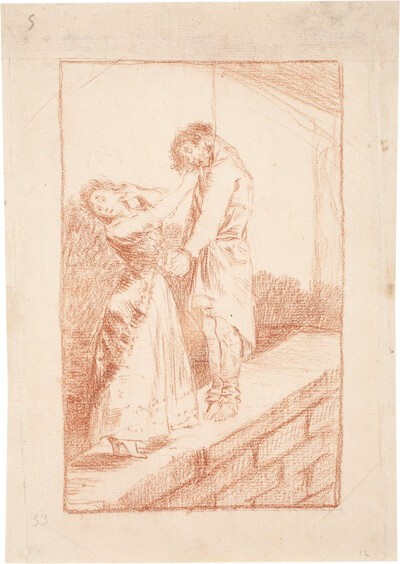- Cronología
- Ca. 1797 - 1798
- Dimensiones
- 219 x 153 mm
- Técnica y soporte
- Aguafuerte, aguatinta bruñida y buril
- Reconocimiento de la autoría de Goya
- Undisputed work
- Ficha: realización/revisión
- 23 Nov 2010 / 21 Jun 2023
- Inventario
- 225
A caza de dientes. (in the lower part)
12. (in the upper right corner)
See Francisco de Goya y Lucientes, Painter.
A first state proof is preserved in the Museum of Fine Arts, Boston, in which the burnishing of the aquatint is incomplete.
The only known state proof is in the Bibliothèque Nationale de France in Paris, where the title On the hunt for molars appears in pen-and-ink manuscript.
The preparatory drawing for this engraving is in the Prado Museum in Madrid.
In the centre of the composition is a man who has just been hanged, hanging handcuffed by a rope. In front of him, a young woman covers her face with a handkerchief in a gesture of horror, while she puts her hand in his mouth and tries to pull out his teeth.
The scene is very dark, so it would seem to be an event that is taking place at night. Goya has applied aquatint profusely over the entire surface of the background and has left the upper part of the hanged man's body and his face blank, as well as the young woman's handkerchief and her hand, with which she pulls his teeth out of his mouth.
This engraving is explained in the three manuscripts of which we are aware. In the Ayala manuscript it is said that "the hanged man's teeth are very effective for spells, what a woman in love is capable of! The one in the Prado Museum points out that "the teeth of hanged men are very effective for spells; without this ingredient nothing useful can be done. It is a pity that the vulgar believe such nonsense". Finally, the meaning of this print is referred to in the manuscript of the National Library: "To get her own way, especially if she is in love, she is capable of pulling out the teeth of a hanged man".
In this engraving, Goya censures the superstition that prompted the young woman to try to extract the corpse's teeth because it was popularly believed that they were useful for love spells. He depicts the scene in an unvarnished, frontal manner, capturing the gruesomeness of the act. This kind of superstition is also reflected in Act VII of the Tragicomedy of Calixto and Melibea, specifically when Celestina tells Parmeno's mother: "Seven teeth he took out of a hanged man with a pair of eyebrow pliers, while I took off his shoes".
Episodes of this nature were also recorded by Leandro Fernández de Moratín (Madrid, 1760-Paris, 1828) in the Inquisition's Auto of Faith on witchcraft held in Logroño in 1610. This work must have been well known to Francisco de Goya, as it had been one of the sources of inspiration for his painting Aquelarre, painted for the Duke and Duchess of Osuna. Moreover, this literary work was in the aristocrats' library, according to the inventory made of it in 1823.
The plate is in poor condition ( National Chalcography, no. 183).
-
Goya. Gemälde Zeichnungen. Graphik. TapisserienKunsthalle BaselBasle1953from January 23th to April 12th 1953cat. 204
-
El arte de GoyaMuseo de Arte Occidental de TokioTokyo1971from 16th 1971 to January 23th 1972. Exhibited also at the Kyoto Municipal Museum of Art, January 29th to March 15th 1972.cat. 60
-
Goya. La década de Los CaprichosMadrid1992organized by Real Academia de Bellas Artes de San Fernando sponsored by Fundación Central Hispano, Madrid, consultant editor Nigel Glendinnig. From October 26th 1992 to January 10th 1993cat. 51
-
GoyaNationalmuseumStockholm1994consultant editors Juan J. Luna and Görel Cavalli-Björkman. From October 7th 1994 to January 8th 1995cat. 55
-
Francisco de GoyaMuseo d'Arte ModernaLugano1996exhibition celebrated from September 22nd to November 17th.cat. 12, p.39
-
Francisco Goya. Sein leben im spiegel der graphik. Fuendetodos 1746-1828 Bordeaux. 1746-1996Galerie KornfeldBern1996from November 21st 1996 to January 1997cat. 18
-
Goya artista de su tiempo y Goya artista únicoThe National Museum of Western ArtTokyo1999from December 1st to July 3th 1999cat. 124
-
Francisco Goya. Capricci, follie e disastri della guerraSan Donato Milanese2000Opere grafiche della Fondazione Antonio Mazzottacat. 12, p.20
-
Goya e la tradizione italianaFondazione Magnani RoccaMamiano di Traversetolo (Parma)2006consultant editors Fred Licht and Simona Tosini Pizzetti. From September 9th to December 3th 2006cat. 12, p.148
-
Goya. Opera graficaPinacoteca del Castello di San GiorgioLegnano2006exhibition celebrated from December 16th 2006 to April 1st 2007p.25
-
Goya et la modernitéPinacothèque de ParisParís2013from October 11st 2013 to March 16th 2014cat. 150
-
2022
-
Goya engravings and lithographs, vol. I y II.Bibliography']['numberOxfordBruno Cassirer1964p.82, cat. 46
-
Vie et ouvre de Francisco de GoyaBibliography']['numberParísOffice du livre1970p.177, cat. 474
-
Goya, la década de los caprichos: dibujos y aguafuertesBibliography']['numberMadridReal Academia de Bellas Artes de San Fernando1992pp.84-86, cat. 50-51
-
Catálogo de las estampas de Goya en la Biblioteca NacionalBibliography']['numberMadridMinisterio de Educación y Cultura, Biblioteca Nacional1996p.80, cat. 100
-
El libro de los caprichos: dos siglos de interpretaciones (1799-1999). Catálogo de los dibujos, pruebas de estado, láminas de cobre y estampas de la primera ediciónBibliography']['numberMadridMuseo Nacional del Prado1999pp.106-109
-
Bellacos, lisonjeros y amigos de mesa defraudadores de la verdad. Caprichos 11, 12 y 13,Boletín de la Real Academia de Bellas Artes de San FernandoBibliography']['numberMadridReal Academia de Bellas Artes de San Fernando2001pp.45-65
-
Bibliography']['number
ParísPinacoteca de París2013p. 215
-
Goya. In the Norton Simon MuseumBibliography']['numberPasadenaNorton Simon Museum2016pp. 42-75
-
Bibliography']['number
Museo de Bellas Artes de Badajoz y Diputación de Badajoz2022p. 33

